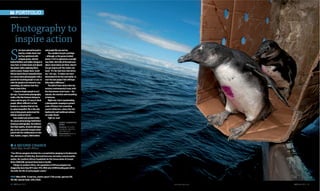
GO_Portfolio
- 1. 60 GO! April 2012 www.gomag.co.za GO! April 2012 61 A SECOND CHANCE Table Bay, South Africa “Two African penguins hesitate for a second before jumping to freedom into the cold waters of Table Bay. Rescued from near starvation several months earlier, the Southern African Foundation for the Conservation of Coastal Birds (SANCCOB) nurtured them back to health. “Unique to southern Africa, the population of African penguins has droppedbymorethan80%since1956.Withonly26000breedingpairsleftin the wild, the life of each penguin counts.” HOW? Nikon D300, 12mm lens, shutter speed 1/160 second, aperture f20, ISO 200, manual mode, with a flash. Photography to inspire action EDITED BY SAM REINDERS CHERYL-SAMANTHA OWEN Reading: The Sudan Handbook, edited by John Ryle et al iPod playlist: Brahms’ violin concerto S he’sbeenpinnedbeneatha boatbyawhaleshark,had herfacesplatteredwith penguinguano,tiptoed behindbuffalosandriddenshotgunin rusty4x4s,inricketyboatsandaboard tinyplaneswhileexploringAfrica anditsoceans.Kenyan-born,South African-basedCheryl-SamanthaOwen isaconservationphotographerwitha passionforteachingpeopletocare.In orderforpeopletobemovedtosave something,shebelievesthatthey havetoloveitfirst. “Iwanttoinspirepeopletoact,” shesays.“Conservationphotography walksathinlinebetweenbeingtoo cutesyandtoogory.It’seasytoshock people.What’sdifficultistofind beautyinasituationthatisn’tby itsnaturebeautiful.Thisistheonly waytohelppeopleunderstandthe delicateworldwelivein.” Samstudiedandworkedwithin theconservationbiologyfieldbefore turningtophotography.Shebelieves thathigh-quality,dramaticphotogra- phycanbeapowerfulweaponwhen pairedwiththecollaborationofscien- tists,leaders,rangers,fieldworkers andpeoplelikeyouandme. Sheconsidersherjobaprivilege –although,astheguanoincident proves,itisn’tasglamorousaspeople maythink.Andwithallthebadnews aboutconservationoutthere,doesn’t she get depressed? She shakes her head.“It’s the bad news that drives me,”she says.“It makes me more determinedtowinthenextbattle,to startthenextprojectthatwillhope- fullymakeadifference.” TheskillofSam’sworkisthatshe textures environmental issues with the interwoven social issues – the animals,thescientistsandeverything in-between. Rightnow,Samisspearheading aphotographiccampaigntoprotect some of Kenya’s last remaining coastal wilderness, where the rich biodiversityandtraditionalcultures areunderthreat. Fighton,Sam!
- 2. 62 GO! April 2012 www.gomag.co.za GO! April 2012 63 PORTFOLIO IT’S RAINING GIRAFFES! Murchison Falls National Park, Uganda “Dirty, hot, sticky and tired after a nine-hour drive south from Uganda’s northern border, we finally turned off the main road and into Murchison Falls National Park. Thoughts of a stiff drink and a shower got the better of my driver – rather than slowing down, his right foot became heavier on the accelerator. “Speeding through a national park is a big no-no, and besides, I wanted to see the wildlife. I objected loudly and we came to a halt.The roar of the engine was replaced with the drumming of a summer downpour. Give nature a chance and you’ll always see something special, like this tower of giraffes that emerged out of the rain.” HOW? Nikon D300, 300mm lens, shutter speed 1/640 second, aperture f4, ISO 640, manual mode. LOCKING HORNS Outside Lake Mburo National Park, Uganda “These impressive beasts, with horns like elephant tusks, must surely be the most imposing of Africa’s domestic livestock.The Ankole cow is a cultural icon for the traditionally nomadic Bahima people of Uganda. “AfteryearsofdisputesbetweenneighbouringcommunitiesandtheUganda WildlifeAuthority(UWA)overtraditionalcattlegrazingsiteswithinLakeMburo NationalPark,FaunaandFloraInternational(FFI)hasencouragedallparties toworktogetheronasolutionthattakesintoaccounttheculturalclaimsof thepeopleandthebiodiversityofthepark.It’satypicalAfricansituationand hopefullytheresultcanbeablueprintforfutureconservationmodels.” HOW? Nikon D300, 300mm lens, shutter speed 1/1600 second, aperture f4.5, ISO 200, manual mode.
- 3. 64 GO! April 2012 www.gomag.co.za GO! April 2012 65 PORTFOLIO STRUGGLING SURVIVOR Tana River Delta, Kenya “Despite having survived the extinction of the dinosaurs, sea turtles like this loggerhead are in great trouble. Only about 1 in 1000 hatchlings survive to adulthood and those that do have to negotiate their way through polluted seas, not mistake a plastic bag for a jellyfish and eat it, and steer clear of the hooks and nets of fishermen. “On Kenya’s north coast, the Local Ocean Trust (LOT) is encouraging fishermentoreleaseratherthanslaughterturtlesthatgetcaughtaccidentally intheirfishinggear.Afinancialincentiveisprovidedtocompensatethose whotakepartintheprogramme.Hopefully,whena25-year-oldfemaleturtle returnstolayhereggsonthebeachwhereshewasborn,shecandososafely.” HOW? Nikon D300, 12mm lens, shutter speed 1/200, aperture f22, ISO 200, manual mode, with a flash. THE REAL PRICE OF SOUP Tana River Delta, Kenya “The plight of sharks being hunted for their fins hit me hardest when I came across this bloodied drying wrack in a remote fishing camp on the Kenyan coast. The only way in and out of this area is by boat, and every month a Chinese agent in the port town of Mombasa collects a delivery of fins from the fishermen. “Nowhere in the sea are sharks safe from exploitation, not even in so- called protected areas – after all, they’re wanderers that don’t adhere to human boundaries. “The main markets for fins are in China and in Chinese communities worldwide, where they are boiled down to add a different texture to chicken soup.” HOW? Nikon D300, 12mm lens, shutter speed 1/125 second, aperture f9, ISO 400, manual mode.
- 4. 66 GO! April 2012 www.gomag.co.za GO! April 2012 67 PORTFOLIO GANNET IN THE BATH Table View, Cape Town “The Cape gannet, with its snow-white body, black-edged wings and distinctive golden crown, is one of southern Africa’s most graceful seabirds. But whether they will continue to fill our skies is questionable, as they have to contend with a polluted sea and dwindling fish stocks. “In this shot, volunteers from SANCCOB are scrubbing oil from a gannet’s feathers. Ships in False Bay regularly release oil by emptying their bilge water, and birds are brought to SANCCOB often, especially in winter, when storms bring that oil to the surface.” HOW? Nikon D300, 12–24mm lens, shutter speed 1/100 second, aperture f6.3, ISO 500, manual mode, with a flash. UNDERWATER SURVEY Near Mombasa, Kenya “Scientists from the International Union for Conservation of Nature (IUCN) measure the growth of coral in the Indian Ocean off the Kenyan coast.The study is helping to determine the effect that a rising sea temperature will have on coral reefs. Coral polyps are slow-growing organisms and the natural resilience of reefs is under threat not only from climate change but also from pollution, overfishing and coastal development. “Scientists estimate that as much as 70% of the world’s coral reefs are in danger and many are already beyond salvation.The reefs in the Caribbean, for example, have lost up to 80% of their coral species.” HOW? Nikon D2x, 10,5mm lens, shutter speed 1/250 second, aperture f13, ISO 200, manual mode, Subal underwater housing and Inon strobes. Visit www.samowenphotography.comtoseemoreofSam’sworkand tofindoutwherehernextprojectwilltakeher.